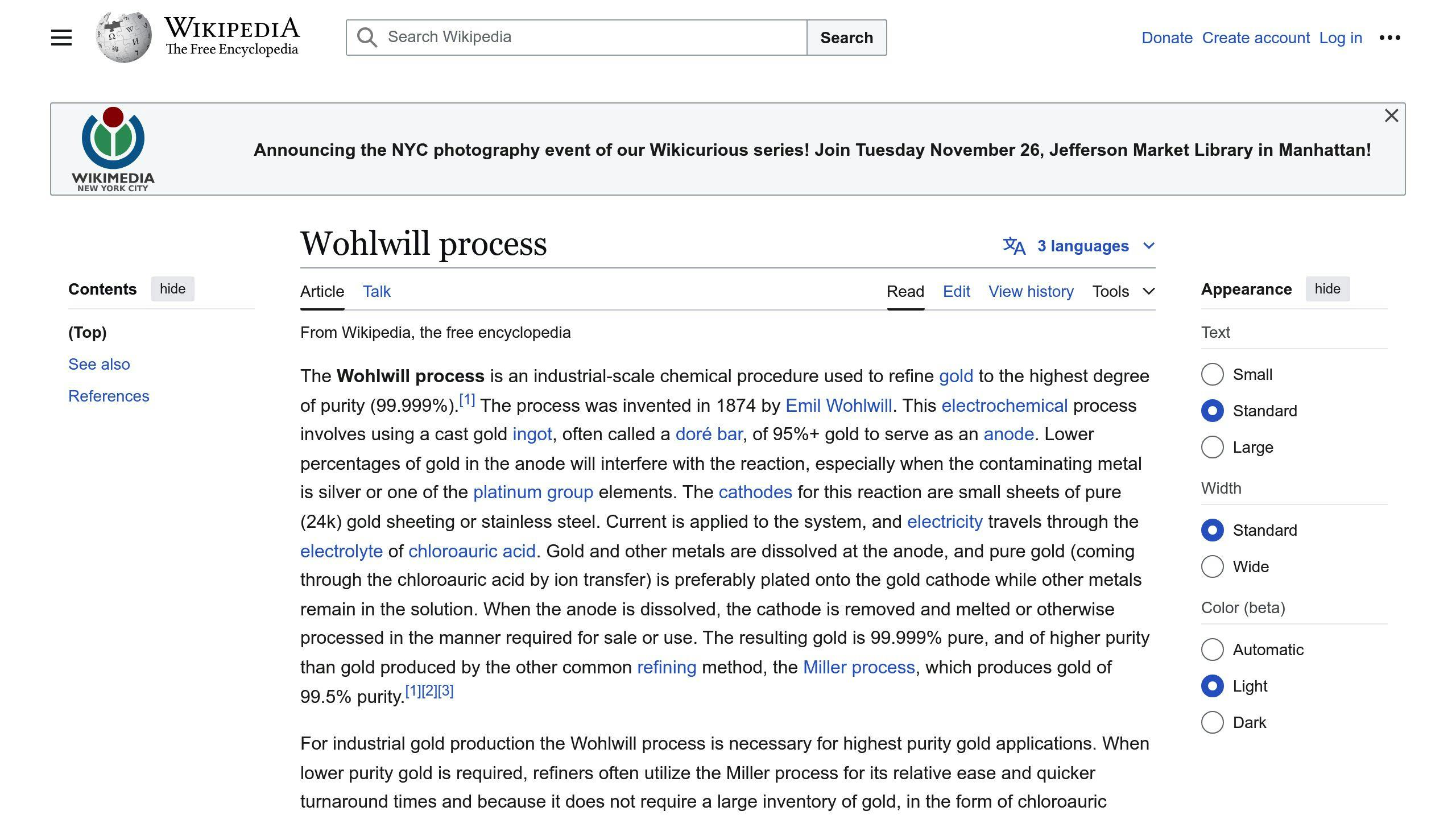Electrolytic gold refining produces ultra-pure gold (up to 99.999%) for luxury jewelry. Here's what you need to know:
- The Wohlwill Process is the gold standard, achieving highest purity
- The Miller Process is faster and more cost-effective (99.5% purity)
- Newer methods like HSSE and SOEC are improving speed and efficiency
Key steps in electrolytic refining:
- Collect and check raw gold
- Smelt and melt
- Remove impurities with chemicals
- Perform electrolytic purification
- Cast and test purity
For luxury jewelers:
- Ultra-pure gold is more valuable and prestigious
- It's easier to work with for complex designs
- Using recycled gold is becoming more popular for sustainability
Quick Comparison:
| Method | Purity | Speed | Cost | Best For |
|---|---|---|---|---|
| Wohlwill | 99.999% | Slow | High | Luxury jewelry |
| Miller | 99.5% | Fast | Moderate | Commercial jewelry |
| Aqua Regia | 99.99% | Moderate | Varies | Lab work, small-scale |
The choice of refining method depends on the specific needs of each jewelry piece and production scale.
Related video from YouTube
The Wohlwill Process

The Wohlwill Process is the top dog in gold refining. It's how you get the purest gold for fancy jewelry. Emil Wohlwill cooked up this method back in 1874, and it's been the go-to ever since.
Purity That's Off the Charts
This process cranks out gold that's 99.999% pure. That's insane. It beats other methods like the Miller Process, which only hits about 99.5%. For the big-time jewelers, this super-pure gold is a must-have for their priciest pieces.
How It Works
Here's the deal with the Wohlwill method:
- You start with a chunk of gold that's at least 95% pure.
- Dunk it in a special acid bath.
- Add some electricity.
- Wait about a day.
- Boom - you've got yourself some ultra-pure gold.
The setup's pretty specific:
- Gold goes on one end (the anode)
- Pure gold or steel strips on the other (the cathode)
- The bath is a mix called chloroauric acid
- Zap it with 1.5 volts
- Keep it toasty at about 65-70°C (160°F)
The gold from the anode dissolves, then sticks to the cathode. All the junk either stays in the liquid or falls to the bottom.
The Catch
Sure, you get the best gold, but there's a trade-off:
- It takes at least 24 hours
- It's NOT cheap
- You need a ton of gold and fancy equipment
- It's a no-go for small-time operations
Green Concerns
Gold refining can be tough on the environment. But some refiners are stepping up:
- Recycling chemicals
- Fixing up old mines
- Getting the right permits to play nice with nature and locals
"Because of the complexity and cost of the Wohlwill Process, it's used only for specific applications." - Manhattan Gold & Silver
Why Fancy Jewelers Love It
For the high-end crowd like Nora Sermez Jewelry, this process is gold (pun intended):
- The gold's super soft, so you can make crazy detailed stuff
- It's shinier than the regular stuff
- You can brag about using 99.999% pure gold
It's overkill for your everyday bling, but for those jaw-dropping, bank-breaking pieces? It's the only way to go.
2. The Miller Process

The Miller Process is a quick, cost-effective gold refining method. Invented by Francis Bowyer Miller in 1867, it's become a go-to in the industry.
This process hits 99.95% gold purity. Not as high as the Wohlwill Process, but it's faster and more efficient.
Here's how it works:
- Melt impure gold in an induction furnace
- Blow chlorine gas through the molten gold
- Impurities react with chlorine, forming chlorides that float up
- Skim off the chloride slag, leaving purified gold
It's quick - just 2 to 4 hours. At the Melbourne Royal Mint, they can process 700 ounces of bullion in 4 hours flat.
The Miller Process has some perks:
- Uses less energy with modern induction furnaces
- Doesn't tie up gold in chloroauric acid
- Simple setup, good for smaller operations
But heads up: you need safety measures for that chlorine gas.
This process is big in the industry. Degussa AG, a major player in precious metals, said about two-thirds of all refined gold had been through the Miller Process as of 1995.
"The process was so successful that it has been adopted at all Australian Mints." - 911Metallurgist
For jewelers like Nora Sermez Jewelry, it's a sweet spot between purity and efficiency. The 99.95% pure gold works great for:
- Big bars for the market
- Most fine jewelry
- Gold coins and bullion
It might not cut it for the fanciest pieces, but for commercial-grade gold jewelry? It's spot on.
sbb-itb-d0b3b91
3. New Cell System Methods
The gold refining industry keeps pushing forward. New cell system methods are changing the game. They're making things faster, purer, and greener. Let's check out some of the cool new stuff happening in electrolytic gold refining.
High-Speed Silver-Electrolysis Plant (HSSE)
In August 2000, the HSSE plant burst onto the scene. It was built to supercharge gold-electrolysis operations. Why? Because people wanted faster, better refining.
Here's what HSSE brings to the table:
- It handles more gold-bearing stuff in less time
- It keeps the gold super pure, even at high speeds
- It's easier on the environment, using less energy and making less waste
Solid Oxide Electrolysis Cell (SOEC) Technology
SOEC tech wasn't made for gold refining, but it's showing a lot of promise. These cells work at high temperatures and are super efficient. They can even team up with other chemical processes.
Check out these SOEC stats:
- Single cells are twice as good as they were 10-15 years ago
- They last 100 times longer
- They can produce 100 times more gas than a decade ago
Peter H. Radcliffe from Rand Refinery says: "Electrolytic dissolution is superior to chemical dissolution for numerous reasons, speed being the most important." This shows how SOEC could be a game-changer in gold refining.
Graphene Oxide and Chitosan Composite
Scientists have cooked up a new material using graphene oxide and chitosan. It's great at pulling gold out of electronic waste - a big deal these days.
This new stuff is pretty impressive:
- It's 10 times better than older materials
- It can grab over 99.5% of the gold by weight
- It only takes 10 minutes, not days like other methods
Daria Andreeva, a researcher, explains: "This combined action of adsorption and reduction makes the process both highly efficient and environmentally friendly, as it avoids the use of harsh chemicals typically employed in gold recovery from electronic waste."
Eco-Friendly Alternatives
The industry is going green. They're using stuff like glycine instead of nasty chemicals to get the gold out.
Vikas Singh from MMTC-PAMP India Pvt Ltd points out another trend: "The implementation of IGDS will likely boost the organised scrap market as it will allow refineries to aggressively source scrap in the domestic market." This means better recycling and a more sustainable refining process.
Automation and Robotics
Digital tech is taking over gold refining. Robots and automated systems are making things more productive and safer. They're cutting down on human error and keeping people away from harmful stuff. This means the whole process runs smoother and faster.
For fancy jewelers like Nora Sermez Jewelry, all this means they can get better gold that's kinder to the planet. As things keep improving, we'll likely see even more efficient and green ways to make the super-pure gold needed for high-end jewelry.
What Works and What Doesn't
Let's dive into the world of electrolytic gold refining. Not all methods are created equal, so let's break down the main processes and see how they stack up.
The Wohlwill Process: Purity Champion
The Wohlwill Process is the top dog when it comes to ultra-high purity. Here's why it's so special:
- It can produce 99.999% pure gold. That's as good as it gets.
- Luxury brands often use this gold for their most exquisite pieces.
But it's not all sunshine and rainbows:
- It's slow. We're talking at least 24 hours to complete.
- It's expensive. The setup and operation costs will make your wallet cry.
- It's not for small operations. You need a lot of gold and fancy equipment.
The Miller Process: Speed Demon
The Miller Process is the go-to for quick, large-scale refining. Here's what makes it tick:
- It's fast. The Melbourne Royal Mint can process 700 ounces of bullion in just 4 hours.
- It's cost-effective. Modern induction furnaces keep energy use down.
- It's great for commercial use. The 99.5% pure gold it produces is perfect for most jewelry and bullion.
But it's not perfect:
- It can't match the Wohlwill Process for ultra-pure gold.
- You need to be careful with the chlorine gas it uses.
Aqua Regia: The Lab Rat
Aqua Regia is a bit of a wild card:
- It can achieve 99.99% purity, almost as good as the Wohlwill Process.
- It's great for refining scrap gold and small-scale operations.
But watch out:
- It's SUPER corrosive. We're talking a mix of nitric and hydrochloric acids. Not for the faint of heart!
- It's better for labs than large-scale industrial refining.
The Showdown
Let's put these methods head-to-head:
| Refining Method | Purity Level | Speed | Cost | Best For |
|---|---|---|---|---|
| Wohlwill Process | Up to 99.999% | Slow | High | Highest purity needs, luxury jewelry |
| Miller Process | Up to 99.5% | Fast | Moderate | Large volume refining, commercial jewelry |
| Aqua Regia | Up to 99.99% | Moderate | Varies | Lab work, small-scale refining |
Expert Take
"Electrolytic dissolution is superior to chemical dissolution for numerous reasons, speed being the most important." - Peter H. Radcliffe, Rand Refinery
This shows why methods like the Wohlwill Process, even though they're slower, are still crucial in the industry.
The Bottom Line
Each method has its place in gold refining. The Wohlwill Process is the purity king but costs a pretty penny. The Miller Process is the industry workhorse, balancing speed and efficiency. Aqua Regia is perfect for lab work and small operations.
For luxury jewelers, the choice often depends on the specific needs of each piece. Ultra-pure Wohlwill gold might be perfect for a showstopping engagement ring, while Miller Process gold could be ideal for a line of more accessible fine jewelry.
Final Thoughts
Let's wrap up our look at electrolytic gold refining. Each method has its place in luxury jewelry making. Here's how they stack up:
The Wohlwill Process is top-notch for purity. It gives you 99.999% pure gold - perfect for the fanciest jewelry. But it's slow and pricey, so it's not great for big operations.
The Miller Process? It's fast. It can handle lots of gold quickly, making it the industry workhorse. The gold isn't as pure (99.5%), but that's fine for most jewelry.
Now, let's talk about being green. Recycling high-value gold scrap is a clear winner. Check out what Benjamin Fritz found:
"The results show that buying gold from precious metal recycling facilities with high technological standards and a reliable origin of the recycling material is about 300 times better than primary production."
That's a big difference! Here's the data:
| Process | Cumulative Energy Demand (CED) | Global Warming Potential (GWP) |
|---|---|---|
| High-value gold scrap recycling | 820 MJ | 53 kg-CO2-Eq. |
| Electronic scrap recycling | 8 GJ | 1 t-CO2-Eq. |
| Mining | 240 GJ | 16 t-CO2-Eq. |
These numbers make a strong case for using recycled gold in luxury jewelry. It's way better for the planet and sidesteps the ethical issues of mining.
For luxury jewelers like Nora Sermez Jewelry, this is big news. Using recycled gold and ethical materials isn't just good for the planet - it's what customers want. They're making beautiful jewelry AND helping the industry do better.
What's next? We'll likely see more eco-friendly refining methods. New tech like the High-Speed Silver-Electrolysis Plant (HSSE) could give us faster, cleaner refining. We might get the best of both worlds: Wohlwill's purity and Miller's speed, without hurting the environment as much.
FAQs
What is the process of gold refining electrolysis?
Gold refining electrolysis, specifically the Wohlwill process, is a method for making ultra-pure gold. Here's how it works:
The process starts with impure gold (at least 95% pure) in a solution of hydrochloric acid and gold chloride. This impure gold acts as the anode (positive electrode), while a thin sheet of high-purity gold serves as the cathode (negative electrode).
When an electric current passes through the solution, gold atoms from the impure anode dissolve and then deposit onto the cathode. Most impurities either stay in the solution or fall to the bottom.
The process works best at 60°C to 70°C (140°F to 158°F) and can take 24 hours or more. The current density is typically 400 to 500 amperes per square meter.
"The Wohlwill process increases purity to about 99.99 percent by electrolysis." - World Gold Council
This method can produce gold that's up to 99.999% pure. It's great for making high-end jewelry, but it's slow and expensive. So, it's not ideal for large-scale operations.
For luxury jewelers like Nora Sermez Jewelry, this process is key. The ultra-pure gold it produces is super malleable and shiny, perfect for their fanciest designs.


Leave a comment